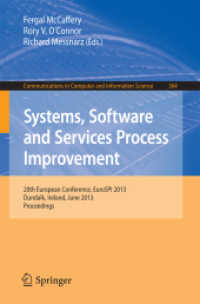Full Description
An essential resource for teachers in inclusive classrooms
This valuable sourcebook offers teachers key strategies on how to design and deliver effective instruction, measure success, and get students to work together. Covering topics such as decoding, vocabulary, blocking, using graphic organizers, mnemonics, literary elements, writing as a process, and doing research, it features dozens of ready-to-use language arts activities that are tied to core curriculum standards, and each activity has adaptations for students with different learning needs.
Contents
About This Book vii
About the Authors ix
Acknowledgments xi
Foreword xiii
Part One: Being Successful in the Inclusive Classroom
Chapter 1: Collaborating Effectively 3
Collaborating for Intervention 3
Collaborating with the Child Study Team 4
Collaborating with Parents and Families 13
Tips for Talking with Parents 16
Chapter 2: Preparing for Differentiated Learning 17
Working with Core Curriculum Standards 17
Assessing Learning Styles 18
Multiple Intelligences and Learning Strengths 20
Planning for Students with Special Needs 21
Chapter 3: Effective Teaching Strategies for Differentiating Instruction 25
The Effective Inclusive Classroom 26
Measuring Success 28
Part Two: Language Arts Activities for the Inclusive Middle School Classroom
Chapter 4: Written Language Conventions 33
Activity 1: Identifying Nouns 34
Activity 2: Identifying Action Verbs 39
Activity 3: Auxiliary and Being Verbs 42
Activity 4: Identifying and Using Modifiers 47
Activity 5: Sentence Mechanics 52
Chapter 5: Writing as a Process 57
Activity 1: Steps to Effective Writing 58
Activity 2: Writing a Personal Narrative 63
Activity 3: Writing Clear Instructions 68
Activity 4: Writing an Essay Comparing and Contrasting Events 74
Activity 5: Writing a Descriptive Essay 80
Activity 6: Writing an Argumentative Essay 84
Activity 7: Writing in the First, Second, and Third Person 89
Activity 8: Writing a Research Paper 94
Chapter 6: Reading Skills 101
Activity 1: Vocabulary Building 102
Activity 2: Spelling 106
Activity 3: Oral Reading Fluency 111
Chapter 7: Reading Comprehension 117
Activity 1: Interpreting Textbooks 118
Activity 2: Interpreting Context Clues 123
Activity 3: Sequencing and Finding the Main Idea 128
Activity 4: Comparing and Contrasting 132
Activity 5: Predicting Outcomes 136
Activity 6: Cause-and-Effect Relationships 140
Activity 7: Reading and Writing Poetry 145
Activity 8: Literary Elements 149
Activity 9: Reading for Meaning 155
Chapter 8: Oral Language 161
Activity 1: Listening Skills 162
Activity 2: Oral Presentations 165
How This Book Maps to Education Standards 171
Glossary 177
Bibliography 179
Index 181








